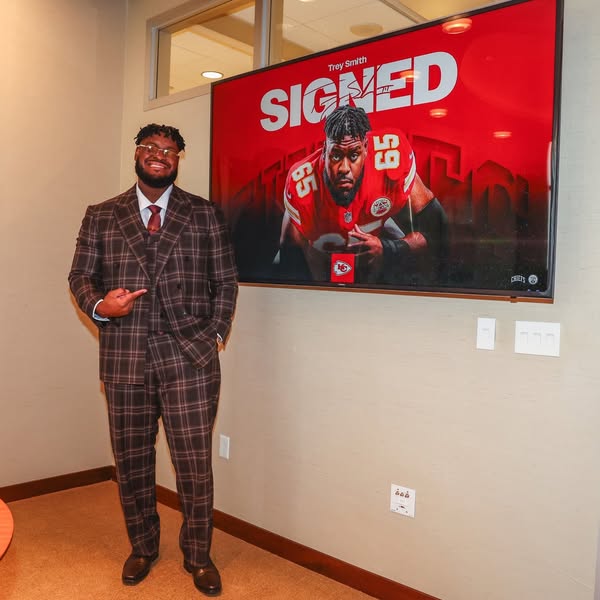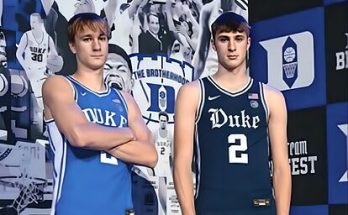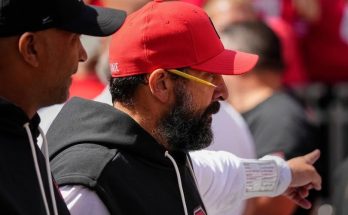Trey Smith’s journey to becoming the highest-paid offensive guard in the NFL is more than just a story of athletic prowess—it’s a tale of perseverance, resilience, talent, and the increasingly vital role of offensive linemen in the modern NFL landscape. When the Kansas City Chiefs signed Smith to a massive four-year, \$94 million contract extension with \$70 million guaranteed, it didn’t just signify a win for the player or the team. It sent a clear message to the entire league: value in the trenches is rising, and teams must invest in protecting their quarterbacks like never before.
To fully understand the magnitude of this deal, we need to start at the beginning. Trey Smith entered the NFL as a sixth-round draft pick in 2021. At pick number 226 overall, few believed he would make an immediate impact—if he even made a team. But for those who followed his college career at Tennessee, his fall in the draft wasn’t about talent or work ethic. It was due to medical concerns—specifically, the discovery of blood clots in his lungs during his time with the Volunteers. These red flags scared off many teams, causing Smith’s draft stock to plummet.
But the Chiefs took a calculated risk, and that risk paid off beyond their wildest expectations. From day one, Trey Smith stepped into a starting role on the Chiefs’ offensive line. He didn’t just hold his own—he excelled. His combination of brute strength, technical discipline, and football intelligence made him one of the most reliable right guards in the league. By the end of his rookie season, it was clear that Smith had vastly outperformed his draft position. By his second year, he was already considered among the top guards in football. By year three, he earned his first Pro Bowl selection. And now, four years into his career, he’s being rewarded with a record-setting contract.
The new contract, which will keep Smith in Kansas City through the 2028 season, averages \$23.5 million per year, making it the richest deal ever for an interior offensive lineman. But what makes this contract truly exceptional isn’t just the total value. It’s the guaranteed money—\$70 million—which surpasses the previous high watermark for guards. In today’s NFL, where player contracts are often laden with non-guaranteed dollars and team-friendly outs, a guarantee of this size demonstrates an extraordinary level of trust and commitment from the Chiefs.
It’s also a shrewd business move. By securing Smith now, the Chiefs avoid the risk of having to either use the franchise tag again or enter next offseason with a major hole to fill. Prior to this extension, the Chiefs had placed the franchise tag on Smith, ensuring that he wouldn’t hit free agency. That tag alone would have cost the team approximately \$23.4 million for one year. Instead, they leveraged the tag as a temporary solution while negotiating a longer-term deal that provides cost certainty and cap flexibility over the next several seasons.
For Kansas City, the decision to prioritize offensive line continuity is both practical and strategic. After all, they are building around the most valuable asset in all of football: Patrick Mahomes. Mahomes is the engine of the franchise, the player around whom everything else revolves. Protecting him is not merely a tactical consideration—it’s an organizational imperative. The Chiefs have experienced both ends of the offensive line spectrum during Mahomes’ career. In their Super Bowl LIV victory, the line gave Mahomes the time and space he needed to carve up defenses. In their Super Bowl LV loss to the Buccaneers, the opposite was true—Mahomes was under siege, running for his life behind a battered and porous line.
Since that loss, the Chiefs have made it a priority to rebuild and invest in the offensive front. The signing of Joe Thuney in 2021 was a major step in that direction. The drafting of Creed Humphrey and Trey Smith that same year gave the team an elite core. Jawaan Taylor was brought in to fortify the tackle position. More recently, the Chiefs traded Thuney to the Patriots to free up cap space, signaling a shift toward building around their younger, homegrown talent. Humphrey also received a major extension earlier this offseason, and now with Smith locked in, the Chiefs have secured two-thirds of their interior line for the long haul.
The broader implications of Smith’s deal extend beyond the Chiefs’ locker room. It reflects a league-wide recalibration of how offensive linemen are valued. In the past, tackles—particularly left tackles—were the only linemen to command top dollar. Guards and centers were often seen as secondary pieces, valuable but replaceable. That mindset is changing. As defensive coordinators increasingly deploy complex interior pressure packages and athletic defensive tackles like Aaron Donald wreak havoc up the middle, the ability to anchor the interior line has never been more important.
Smith’s deal sets a new benchmark for guards, and it’s likely that other elite interior linemen will now push for similar figures. Players like Alijah Vera-Tucker of the Jets, Landon Dickerson of the Eagles, and Wyatt Teller of the Browns will all have a stronger case when it comes time for their next contracts. Just as quarterback salaries have spiraled upward due to market demand, so too will the compensation for the men tasked with protecting them.
But Smith’s value to the Chiefs goes beyond the Xs and Os. He’s a leader in the locker room, a respected voice among teammates, and a positive force in the Kansas City community. His work ethic and humility have made him a fan favorite, and his willingness to play through pain has earned him the admiration of coaches and peers alike. In many ways, he embodies the Chiefs’ organizational ethos—tough, smart, disciplined, and team-first.
It’s also worth noting the financial wisdom of securing a player like Smith now, rather than waiting. With the NFL salary cap projected to continue rising in the years ahead, today’s expensive contract could look like a bargain in just a few seasons. What seems like an extravagant outlay now may very well prove to be a market-efficient deal by 2027 or 2028. The Chiefs have often shown a knack for this kind of foresight. They signed Mahomes to a 10-year deal in 2020 that now looks incredibly team-friendly given the current quarterback market. Their willingness to pay Smith at the top of the market may similarly look like a bargain if he continues to perform at a Pro Bowl level.
From a football standpoint, Smith’s presence allows the Chiefs to maintain offensive versatility. He’s a dominant run-blocker, frequently driving defenders off the line of scrimmage and creating clear lanes for backs. In pass protection, his anchor strength and hand technique make him nearly impossible to bull-rush. His ability to pick up stunts and blitzes adds a layer of confidence for Mahomes, allowing the quarterback to stay in rhythm and execute at a high level.
There’s also a psychological edge to having a player like Smith in the huddle. He brings a physicality and swagger that’s contagious. Opposing defenders know that they’re in for a long, bruising day when they line up across from him. That kind of tone-setting presence can be invaluable, especially in high-stakes games where toughness and attitude often determine outcomes.
Looking ahead, Smith’s extension gives the Chiefs a degree of roster clarity that most franchises envy. With Mahomes, Travis Kelce, Creed Humphrey, Jawaan Taylor, and now Trey Smith all under contract through at least 2026, Kansas City has a clear blueprint for sustained success. They can now focus on surrounding this core with emerging talent at the skill positions and on defense.
Of course, NFL contracts are always a gamble to some extent. Injuries happen. Performance can decline. But in Smith’s case, the risk appears minimal. He has already overcome serious medical adversity to become one of the league’s most durable and effective linemen. His age—just 25 at the time of the deal—means his prime years are still ahead of him. And his professionalism suggests he won’t be complacent just because he got paid.
In sum, Trey Smith’s new contract is a win for everyone involved. It rewards a deserving player. It strengthens a championship roster. It sets a new standard for a vital position. And it reinforces the notion that in today’s NFL, success starts up front. The Chiefs are betting big on their offensive line—and given their track record, it’s a smart bet.
Trey Smith’s \$94 million extension isn’t just about money. It’s about commitment, identity, and vision. It’s about recognizing where the game is headed and making sure your team is prepared to thrive in that future. The Chiefs have been one of the NFL’s most successful franchises over the last five years, and deals like this help explain why. They don’t just chase stars—they build foundations. And in Trey Smith, they’ve secured a cornerstone for years to come.



